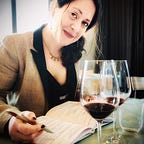Feinherb is Germany’s Love Language
Once banned by law, the hard-to-define style is a window into a winemaker’s soul.
There’s safety, so we’re often told, in numbers. Nowhere is that more apparent than when it comes to the world of German wine. A rule — and classification — exists for seemingly every eventuality. Kabinett, spätlese, auslese, halbtrocken, eiswein: Each style and attribute conform to a calibrated set of rules and readings. For example, trocken (dry) refers to wines with a residual sugar content of up to 4 grams per liter. But it can go up as high as 9 grams per liter when the amount of residual sugar is correlated with the amount of total acidity, based on this mathematical formula: g/l acidity + 2 ≤ 9 grams of residual sugar. See what I mean?
On the bright side, this same exactitude has earned these wines praise for their laser focus, sleek precision, and verve. Adjectives that could just as easily be used to describe the latest BMW model as this vintage’s bottling. This is how wine is done in Germany.
Except when it isn’t. Enter feinherb, a term describing a style of German wine that’s as freethinking and fantastical as the rest of it is tightly controlled. Feinherb is poetry in a bottle, German for whimsy.
Unlike its strictly regimented counterparts, feinherb is a style of wine that is nothing short of lawless. It actively refutes hardline data and standardization in lieu of instinct, impulse, and intuition. It is defined by a position — balance — rather than a mathematical equation. A historical classification acceding control to a higher power, it illustrates a winemaker’s respect for Germany’s cool climate, steep stony cliffs and riesling’s naturally high acidity with far greater certainty than any rulebook or refractometer. A naturally achieved crossroads of yeast, sugar, and alcohol of which Robert Johnson would be proud.
Feinherb is a style of wine that is nothing short of lawless
It is a concept so anarchic, in fact, that with the redo of the German Wine Law in 1971, feinherb was officially banned from labels. Thankfully for the wine world at large, a dedicated cadre of troublemakers — spearheaded by the late Annegret Reh-Gartner, owner of the storied Weingut Reichsgraf von Kesselstatt in Morscheid — refused to let the historically significant style disappear. She led a quiet but active rebellion on their labels by retaining the term. Soon thereafter began a protracted court fight that ended in 2003, with feinherb’s official recognition renewed.
Leaving a word on the label may not seem like a particularly radical step, but in the German winemaking world, it was the equivalent of storming the barricades. Why? Because even in a national legislative environment that forces winemakers into a cinched corset of classifications, there has to be space for self-expression. And in this way, the feinherb designator provides a riesling release valve.
When a dancer performs Swan Lake on the stage, her lightness is not evaluated by the numbers shown in the pale light of her bathroom scale. Rather, she is judged by the perception of her lightness: Lightness as she interacts with the stage set, with the other dancers, with gravity, with her own weight. It is about the interaction of the individual pieces and how those pieces come together in the final performance.
Living and breathing from this same perception — taste — of balance, Dr. Katharina Prüm of Germany’s legendary Mosel estate Joh. Jos. Prüm calls it “part harmony and part coherence, a state where everything meshes. Everything on one plane.”
Feinherb is not, as some wine books and sites wrongfully claim, simply a fashionable synonym for “semi-dry.” Instead, feinherb carries a plucky sensibility of “off-dry,: or even “off-dry-ish.” Its existence is completely up to the whims of nature and the winemaker. Furthermore, in an act of utter chaos and abandon, feinherb may be used in conjunction with official ripeness-level terms, opening the door to wines with names such as 2016 Trarbacher Hühnerberg Riesling Kabinett Feinherb. Rest assured, though. As daunting as it sounds, one need only remember that feinherb on the label is little more than a quiet marker of balance. This is what makes it so controversial and unique in the world of wine, a true poetic expression of a place.
Feinherb is not, as some wine books and sites wrongfully claim, simply a fashionable synonym for “semi-dry”
Yet even within the total 100,000 hectares of classified winegrowing area in Germany, a size more or less equivalent to that of Bordeaux, regional differences in tastes and traditions, varieties, geography and geology mean that ultimately feinherb is in the eye of the beholder. Bottles reveal as much, if not more, about the winemaker than they do about the wines. Balance in the southern wine-growing region of Baden, for example, traditionally means a wine of weight, depth and opulence. A balanced wine in the steep northern Mittelrhein, in contrast, is sleek with a taut line linking fruit and acidity.
Feinherb as a style is capable of going places few other rieslings can, respecting an internal harmony dictated by the natural conditions of geology and geography. While there are numerous accepted techniques to manipulate the fermentation process — to speed up, jump start, stall or stop it altogether — the point at which the fermentation naturally ceases is at its most basic level the heartbeat of the wine.
This heartbeat resonates in a way that a number dominated formula can never achieve. How and if that heartbeat is respected will reveal key insights into a winemaker’s attitude toward her wines, as well as her overall philosophy of balance. A well-made feinherb will distill its creator’s perception of the vintage into a shorthand that few other wines offer — like peeking at someone’s music collection or the books on their shelves. More than an interpretation of a singular style, feinherb is a liquid window into the winemaker’s soul.
*A version of this article appeared on www.jancisrobinson.com
